Assessing the Influence of Water Conservancy Projects on China’s Reserve Resources for Cultivated Land
Abstract
:1. Introduction
2. Materials and Methods
2.1. Study Area
2.2. Comprehensive Evaluation System for Potential RRCL
2.2.1. Construction of a Theoretical Framework for Evaluations
2.2.2. Computation of RRCL Evaluation Indexes
- (1)
- Standardization process for the evaluation indexes
- (2)
- Determination of weights for the indicators
- (3)
- Comprehensive evaluation model
2.3. Zoning of RRCL with Different Development Potential
2.4. Data Sources and Processing
- (1)
- Natural quality evaluation involves geographical environment data, soil data and climate data. The geographical environment data were obtained from STRM-DEM data (spatial resolution of 30 m) released by the United States’ Space Shuttle Radar Topographic Measurement Program, and four topographic and geomorphological indicators including slope, undulation, altitude, and slope direction were obtained by ArcGIS processing. The soil data were extracted from the 1:1 × 104 soil database released by the Chinese Academy of Sciences (accessed on 30 September 2022), with a spatial resolution in 1 km × 1 km, to extract four indicators of soil type, sediment concentration, pH value and thickness of tillage layer. Additionally, the climate data used the light and heat data from the National Meteorological Science Data Center (http://www.resdc.cn (accessed on 31 December 2021)) and interpolated the data of 720 national meteorological stations in the northern region by the inverse distance weighting method to obtain two indicators of ≥10 °C cumulative temperature and sunshine hours. The precipitation data were obtained from the China Meteorological Background Data Set corrected by DEM in the Resource and Environmental Science and Data Center of the Chinese Academy of Sciences (http://www.resdc.cn (accessed on 9 January 2023)), and the index of annual average precipitation was obtained by the inverse distance weight method.
- (2)
- Functional quality evaluation involves the functions of farming and transportation. The distance from the village as well as the distance from the road were used as the evaluation indexes, respectively. ArcGIS10.7 was used to buffer the villages, roads, and water conservancy projects to obtain the distance distribution map. The results of national land use planning were the data source.
- (3)
- Environmental quality evaluation involves ecological risk indexes. The ecological risk index used the structural risk index and the desertification index as the evaluation indicators. The NDVI data involved were obtained from the MODIS data processed by the Remote Sensing Unit of the Institute of Agricultural Resources and Agricultural Division of the Chinese Academy of Agricultural Sciences.
- (4)
- The irrigation conditions mainly consider the distance from constructed reservoirs and those that are under construction or planned, water diversion projects, irrigation areas and other water conservancy projects. Additionally, a distance distribution map was obtained by using ArcGIS10.7 to buffer the water conservancy projects. The data sources for constructed water conservancy projects were mainly from the National Water Census, China Hydropower Yearbook and National Reservoir Dataset (CRD: China Reservoir Dataset), and the sources for water conservancy projects under construction and planned were the 172 major national water conservancy projects since 2014 and 150 major water conservancy projects during 2020–2022.
3. Results
3.1. Distribution of Unused Land and Water Conservancy Projects in the Study Area
3.2. Results of RRCL Quality Evaluations
3.2.1. Natural Quality Evaluation under Rain-Fed and Irrigated Scenarios
3.2.2. Functional and Environmental Quality Evaluations
3.3. Zoning of RRCL Quality in Six Provinces
4. Discussion
4.1. Significant Impact on Irrigation Conditions Provided by Water Conservancy Projects in the Northern Region
4.2. Ecological Protection Measures Should Be Considered in the Future Development of RRCL
5. Conclusions
Author Contributions
Funding
Data Availability Statement
Conflicts of Interest
Appendix A
| Dimensions | Second Level Index | Grading Assignment Criteria of Indicators | Index Weight | ||||
|---|---|---|---|---|---|---|---|
| Level 1 0~25 Points | Level 2 26~50 Points | Level 3 51~75 Points | Level 4 76~100 Points | Rain-Fed Scenario | Irrigation Scenario | ||
| Natural Quality | Surface undulation, degree | 500~200 | 200~70 | 70~30 | <30 | 0.045 | 0.045 |
| Slope, degree | 15~10 | 10~6 | 6~2 | <2 | 0.03 | 0.03 | |
| Altitude, m | 6000~3000 | 3000~2000 | 2000~1200 | <1200 | 0.0375 | 0.0375 | |
| Slope direction | North | Northwest | Northeast | South, Southeast, Southwest | 0.0375 | 0.0375 | |
| Thickness of tillage layer, mm | 30~60 | 60~100 | 100~150 | >150 | 0.066 | 0.066 | |
| Soil type | sandy soil | sandy soil | clay | loamy soil | 0.086 | 0.086 | |
| Soil sediment content, % | 100~60 | 60~50 | 50~40 | <40 | 0.028 | 0.028 | |
| Soil pH | 4~5, 9~8 | 5~5.5, 8~7.5 | 5.5~6, 7.5~7 | 6, 7.5~7 | 0.02 | 0.02 | |
| ≥10 °C accumulated temperature | 1800~2500 | 2500~3500 | 3500~4500 | >4500 | 0.05 | 0.05 | |
| Sunshine hours, h | 500~1000 | 1000~2000 | 2000~3000 | >3000 | 0.04 | 0.04 | |
| Precipitation, mm | 400~450 | 450~500 | 500~600 | >600 | 0.1 | 0.1 | |
| Irrigation water conditions, km | >5 | 5~3 | 3~2 | <2 | — | — | |
| Functional Quality | Distance from villages, m | 5000~4000 | 4000~3000 | 3000~2000 | <2000 | 0.13 | 0.13 |
| Distance from field roads, m | 4000~3000 | 3000~2500 | 2500~1500 | <1500 | 0.12 | 0.12 | |
| Environmental Quality | Structural risk index | 0~0.25 | 0.25~0.5 | 0.5~0.75 | 0.75~1 | 0.05 | 0.05 |
| Desertification index | 0~10 | 10~30 | 30~50 | >50 | 0.05 | 0.05 | |
References
- Zhu, X.; Xiao, G.; Wang, S. Suitability evaluation of potential arable land in the Mediterranean region. J. Environ. Manag. 2022, 313, 115011. [Google Scholar] [CrossRef] [PubMed]
- Wang, Q.; Liu, X.H.; Tian, X.; Wang, C.L.; Wilson, P. Using models and spatial analysis to analyze spatio-temporal variations of food provision and food potential across China’s agro-ecosystems. Ecol. Model. 2015, 306, 152–159. [Google Scholar] [CrossRef]
- Wang, Y.B.; Wu, P.T.; Engel, B.A.; Sun, S.K. Comparison of volumetric and stress-weighted water footprint of grain products in China. Ecol. Indic. 2015, 48, 324e333. [Google Scholar] [CrossRef]
- Zhu, L.; Bai, Y.; Zhang, L.; Si, W.; Wang, A.; Weng, C.; Shu, J. Water–Land–Food Nexus for Sustainable Agricultural Development in Main Grain-Producing Areas of North China Plain. Foods 2023, 12, 712. [Google Scholar] [CrossRef] [PubMed]
- Yu, Z.; Deng, X. Assessment of land degradation in the North China Plain driven by food security goals. Ecol. Eng. 2022, 183, 106766. [Google Scholar] [CrossRef]
- Li, P.; Chang, Z.; Chen, W. Risk state evaluation model for China’s food import using G1-LS and variable weight SPA based on bottom-line thinking. Kybernetes 2023. ahead of print. [Google Scholar] [CrossRef]
- He, G.; Zhao, Y.; Wang, L.; Jiang, S.; Zhu, Y. China’s food security challenge: Effects of food habit changes on requirements for arable land and water. J. Clean. Prod. 2019, 229, 10. [Google Scholar] [CrossRef]
- Li, W.; Wang, D.; Li, H.; Liu, S. Urbanization-induced site condition changes of peri-urban cultivated land in the black soil region of northeast China. Ecol. Indic. 2017, 80, 215–223. [Google Scholar] [CrossRef]
- Chen, Y.; Li, B.; Fan, Y.; Sun, C.; Fang, G. Hydrological and water cycle processes of inland river basins in the arid region of Northwest China. J. Arid Land 2019, 11, 161–179. [Google Scholar] [CrossRef]
- FAO; ITPS. Status of the World’s Soil Resources (SWSR)—Main Report; Food and Agriculture Organization of the United Nations and Intergovernmental Technical Panel on Soils: Rome, Italy, 2015. [Google Scholar]
- Wang, H.; Wang, L.; Yang, G.; Jia, L.; Yao, Y.; Zhang, Y. Agricultural water resource in China and strategic measures for its efficient utilization. Strateg. Study Chin. Acad. Eng. 2018, 20, 9–15. (In Chinese) [Google Scholar] [CrossRef]
- Xu, X.; Wang, L.; Xu, Y.; Duan, J. Evaluation of reserve available land resources based on three types of territorial space: A case study of Jiexiu City in Shanxi Province. Prog. Geogr. 2021, 40, 272–282. [Google Scholar] [CrossRef]
- Li, Q.F.; Huang, Y.; Du, G.M.; Qu, S.J.; Li, Y.Q. Evolutionary characteristics of spatial and temporal patterns of cultivated land yields in the black soil region of northeast China from 2000 to 2020. J. China Agric. Univ. 2023, 28, 188–197. (In Chinese) [Google Scholar]
- Zhao, R.; Li, J.; Wu, K.; Kang, L. Cultivated Land Use Zoning Based on Soil Function Evaluation from the Perspective of Black Soil Protection. Land 2021, 10, 605. [Google Scholar] [CrossRef]
- Némethová, J.; Svobodová, H.; Věžník, A. Changes in Spatial Distribution of Arable Land, Crop Production and Yield of Selected Crops in the EU Countries after 2004. Agriculture 2022, 12, 1697. [Google Scholar] [CrossRef]
- Liu, Q.; Xiao, H.F. Impact of agricultural land operation scale and financial support policy on agricultural carbon emissions. Resour. Sci. 2020, 42, 1063–1073. [Google Scholar]
- Xu, X.; He, P.; Pampolino, M.F.; Qiu, S.; Zhao, S.; Zhou, W. Spatial variation of yield response and fertilizer requirements on regional scale for irrigated rice in China. Sci. Rep. 2019, 9, 3589. [Google Scholar] [CrossRef]
- Ying, T.; Menghan, C. Impact Mechanism and Effect of Agricultural Land Transfer on Agricultural Carbon Emissions in China: Evidence from Mediating Effect Test and Panel Threshold Regression Model. Sustainability 2022, 14, 13014. [Google Scholar]
- Wu, K.N.; Yang, Q.J.; Zhao, R. A Discussion on Soil Health Assessment of Arable Land in China. Acta Pedol. Sin. 2021, 58, 537–544. (In Chinese) [Google Scholar]
- Xu, J.; Tang, S.; Li, P.; Zhang, H. Empirical Study on the Grain Output Based on Regression Analysis. J. Sens. 2022, 2022, 2567790. [Google Scholar] [CrossRef]
- Yi, L.; Zhang, Z.; Wang, X.; Liu, B.; Zuo, L.; Zhao, X.; Wang, J. Spatial-temporal change of major reserve resources of cultivated land in China in recent 30 years. Trans. Chin. Soc. Agric. Eng. 2013, 29, 1–12. (In Chinese) [Google Scholar]
- Zhou, Z.; Chen, T.; Li, L.; Wang, X.; Feng, X.; Lu, J. Projected Losses of Ecosystem Services Incurred by Reserve Resources of Cultivated Land Development and Development Priority: A Case Study of Linzhou City in Henan Province, China. Int. J. Environ. Res. Public Health 2022, 19, 6627. [Google Scholar] [CrossRef] [PubMed]
- Aini, L.N.; Prasetyo, J.; Makiyah, S.N.N. Mulyono Evaluation of land suitability for Yam (Dioscorea alata) in Cangkringan, Sleman, Special Region of Yogyakarta. IOP Conf. Ser. Earth Environ. Sci. 2021, 752, 012029. [Google Scholar] [CrossRef]
- Sahoo, S.; Sil, I.; Dhar, A.; Debsarkar, A.; Das, P.; Kar, A. Future Scenarios of Land-Use Suitability Modeling for Agricultural Sustainability in a River Basin. J. Clean. Prod. 2018, 205, 313–328. [Google Scholar] [CrossRef]
- Murad; Sumarsono, J.; Hidayat, A. Land Evaluation Suitability for Tobacco (Nicotiana tabacum L.) in Lombok Island Province of West Nusa Tenggara with Geographic Information System (GIS). IOP Conf. Ser. Earth Environ. Sci. 2019, 355, 012056. [Google Scholar] [CrossRef]
- Ahmed, G.B.; Shariff, A.R.M.; Balasundram, S.K.; bin Abdullah, A.F. Agriculture land suitability analysis evaluation based multi criteria and GIS approach. IOP Conf. Ser. Earth Environ. Sci. 2016, 37, 012044. [Google Scholar] [CrossRef]
- Zhao, Y.; Wang, H.; Ma, H.; He, G.H.; He, F. Analysis of long-term consumption effects of cascade complementary energy storage on new energies. J. Hydraul. Eng. 2022, 53, 1271–1279+1290. (In Chinese) [Google Scholar]
- Bi, W.; Dang, X.; Ma, H.; Deng, M.; Li, P.; Cao, X.; Shi, P. Evaluation of arable land suitability and potential from the perspective of ‘Food Crop Production Strategy based on Farmland Management’ in northwest China. Trans. Chin. Soc. Agric. Eng. 2021, 37, 235–243. [Google Scholar]
- Liu, X.; Xu, Y.; Sun, S.; Zhao, X.; Wang, Y. Analysis of the Coupling Characteristics of Water Resources and Food Security: The Case of Northwest China. Agriculture 2022, 12, 1114. [Google Scholar] [CrossRef]
- Goh, C.S.; Wicke, B.; Potter, L.; Faaij, A.; Zoomers, A.; Junginger, M. Exploring under-utilised low carbon land resources from multiple perspectives: Case studies on regencies in Kalimantan. Land Use Policy 2017, 60, 150–168. [Google Scholar] [CrossRef]
- Sheng, Y.; Liu, W.; Xu, H.; Gao, X. The Spatial Distribution Characteristics of the Cultivated Land Quality in the Diluvial Fan Terrain of the Arid Region: A Case Study of Jimsar County, Xinjiang, China. Land 2021, 10, 896. [Google Scholar] [CrossRef]
- Zhang, T.; Wang, J.; Teng, Y. Adaptive Effectiveness of Irrigated Area Expansion in Mitigating the Impacts of Climate Change on Crop Yields in Northern China. Sustainability 2017, 9, 851. [Google Scholar] [CrossRef]
- Fernandez-Guajardo, P.; Weber, E.P.; Seales, L. Solving the Food-Water-Energy Nexus One Step at a Time: Modernizing Irrigated Agriculture in Hood River, Oregon. J. Sustain. Dev. 2023, 16, 1–95. [Google Scholar] [CrossRef]
- Zhonghe, L.; Chesheng, Z.; Shi, H. Yield effects of irrigated acreage change under climate change in China. Trans. Chin. Soc. Agric. Eng. 2021, 37, 94–104. (In Chinese) [Google Scholar]
- Quan, B.; Zhu, H.J.; Chen, S.L.; Römkens, M.J.M.; Li, B.C. Land suitability assessment and land use change in Fujian Province, China. Pedosphere 2007, 17, 493–504. [Google Scholar] [CrossRef]
- Xiao, P.; Zhao, C.; Zhou, Y.; Feng, H.; Li, X.; Jiang, J. Study on Land Consolidation Zoning in Hubei Province Based on the Coupling of Neural Network and Cluster Analysis. Land 2021, 10, 756. [Google Scholar] [CrossRef]
- Xu, F.; Shao, Y.; Xu, B.; Li, H.; Xie, X.; Xu, Y.; Pu, L. Evaluation and Zoning of Cultivated Land Quality Based on a Space–Function–Environment. Land 2023, 12, 174. [Google Scholar] [CrossRef]
- Yalew, S.G.; Van Griensven, A.; van der Zaag, P. AgriSuit: A web-based GIS-MCDA framework for agricultural land suitability assessment. Comput. Electron. Agric. 2016, 128, 1–8. [Google Scholar] [CrossRef]
- Lander, B. Birds and beasts were many: The ecology and climate of the Guanzhong basin in the pre-imperial period. Early China 2020, 43, 207–245. [Google Scholar] [CrossRef]
- Liu, J.; Chen, X.; Chen, W.; Zhang, Y.; Wang, A.; Zheng, Y. Ecosystem Service Value Evaluation of Saline—Alkali Land Development in the Yellow River Delta—The Example of the Huanghe Island. Water 2023, 15, 477. [Google Scholar] [CrossRef]
- Fan, X.; Yu, H.; Tiando, D.S.; Rong, Y.; Luo, W.; Eme, C.; Ou, S.; Li, J.; Liang, Z. Impacts of Human Activities on Ecosystem Service Value in Arid and Semi-Arid Ecological Regions of China. Int. J. Environ. Res. Public Health 2021, 18, 11121. [Google Scholar] [CrossRef]
- He, G.H. Evaluation of Spatial Optimization of Land and Water Resources in Northern China and Its Ecological Effects; China Institute of Water Resources and Hydropower Research: Beijing, China, 2019. (In Chinese) [Google Scholar]
- Huan, L. Introduction to the Research of Marginalization of Agricultural Land, 1st ed.; China Social Sciences Press: Beijing, China, 2023; pp. 154–196. [Google Scholar]
- Zhao, A.D.; Xu, S.; Zeng, W.; Qu, F.T.; Ma, X.L. Analysis of unstable farmland in arid and semi-arid regions and feasibility evaluation of its conversion. Trans. Chin. Soc. Agric. Eng. 2016, 32, 215–225. (In Chinese) [Google Scholar]
- Zhou, J.; Zhang, F.R.; Xu, Y.; Qiu, M.L. Land cultivation suitability evaluation of agro-pastoral ecotone in northern China based on aspects of ecology, production and life. Trans. Chin. Soc. Agric. Eng. 2019, 35, 253–260. (In Chinese) [Google Scholar]
- Akpoti, K.; Kabo-bah, A.T.; Zwart, S.J. Agricultural land suitability analysis: State-of-the-art and outlooks for integration of climate change analysis. Agric. Syst. 2019, 173, 172–208. [Google Scholar] [CrossRef]
- Tang, H.; Niu, J.; Niu, Z.; Liu, Q.; Huang, Y.; Yun, W.; Shen, C.; Huo, Z. System Cognition and Analytic Technology of Cultivated Land Quality from a Data Perspective. Land 2023, 12, 237. [Google Scholar] [CrossRef]
- Sun, X.-B.; Kong, X.-B.; Wen, L.-Y. Evaluation index system of cultivated land quality and its development trend based on cultivated land elements. Chin. J. Soil Sci. 2019, 50, 739–747. [Google Scholar]
- Zhou, H.; Lei, G.; Yang, X.; Zhang, K. Utilization zoning of reserve resources for cultivated land based on two-dimensional graph theory clustering method at countyscale. Trans. Chin. Soc. Agric. Mach. 2017, 48, 116–124. (In Chinese) [Google Scholar]
- Ye, D.; Wu, K.N.; Liu, P.J. Developmental potentiality evaluation of cultivated land reserve in Jingtai based on normal cloud and entropy weight. Chin. J. Agric. Resour. Reg. Plan. 2016, 37, 22–28. (In Chinese) [Google Scholar]
- Kahsay, A.; Haile, M.; Gebresamuel, G.; Mohammed, M. Land suitability analysis for sorghum crop production in northern semi-arid Ethiopia: Application of GIS-based fuzzy AHP approach. Cogent Food Agric. 2018, 4, 1507184. [Google Scholar] [CrossRef]
- Weng, R.; Jin, X.B.; Zhang, X.L.; Han, B.; Gu, Z.M.; Zhou, Y.K. Delimitating permanent prime farmland reserve areas on a perspective of suitability-cluster-stability. Trans. Chin. Soc. Agric. Eng. 2022, 38, 269–278. (In Chinese) [Google Scholar]
- Liu, D.; Liu, C.; Fu, Q.; Li, M.; Faiz, M.A.; Khan, M.I.; Cui, S. Construction and application of a refined index for measuring the regional matching characteristics between water and land resources. Ecol. Indic. 2018, 91, 203–211. [Google Scholar] [CrossRef]
- He, Z.; He, W.; Li, L.; Zhang, J.; Li, H. Analysis of factors influencing quality of newly increased cultivated land and grain productivity in arid highland area-taking occupation complementary balance project as an example. J. Drain. Irrig. Mach. Eng. 2022, 40, 1151–1158, 1166. [Google Scholar]
- Shang, Z.H.; Cao, J.J.; Degen, A.A.; Zhang, D.W.; Long, R.J. A four year study in a desert land area on the effect of irrigated, cultivated land and abandoned cropland on soil biological, chemical and physical properties. Catena 2019, 175, 1–8. [Google Scholar] [CrossRef]
- Katz, D. Rehabilitating Israel’s Streams and Rivers. Int. J. River Basin Manag. 2012, 10, 317–330. [Google Scholar]
- Zhao, Y.; Huang, Y.; Wang, H.; Xiao, W.; Wang, H. Study on regional climate effect under water diversion in Northwest China. J. Hydraul. Eng. 2022, 53, 270–283+295. [Google Scholar]
- Saidou, A.; Illou, M. Problem of the Profitability of Irrigated Agriculture in the Sahel Environment: Case of Producers of the Konni Hydro-Agricultural Development. J. Agric. Chem. Environ. 2023, 12, 206–222. [Google Scholar]
- Hou, Y.; Chen, Y.; Ding, J.; Li, Z.; Li, Y.; Sun, F. Ecological Impacts of Land Use Change in the Arid Tarim River Basin of China. Remote Sens. 2022, 14, 1894. [Google Scholar] [CrossRef]
- Wang, Q.; Li, W.; Li, T.; Li, X.; Liu, S. Goaf water storage and utilization in arid regions of northwest China: A case study of Shennan coal mine district. J. Clean. Prod. 2018, 202, 33–44. [Google Scholar] [CrossRef]
- Chen, Y.; Hao, X.; Chen, Y.; Zhu, C. Study on Water System Connectivity and Ecological Protection Countermeasures of Tarim River Basin in Xinjiang. Bull. Chin. Acad. Sci. 2019, 34, 1156–1164. [Google Scholar]
- Xue, L.; Wang, J.; Zhang, L.; Wei, G.; Zhu, B. Spatiotemporal analysis of ecological vulnerability and management in the Tarim River Basin, China. Sci. Total Environ. 2019, 649, 876–888. [Google Scholar] [CrossRef]
- Long, H.; Liu, Y.; Hou, X.; Li, T.; Li, Y. Effects of land use transitions due to rapid urbanization on ecosystem services: Implications for urban planning in the new developing area of China. Habitat Int. 2014, 44, 536–544. [Google Scholar] [CrossRef]
- Huang, C.; Zhou, Z.; Teng, M.; Wu, C.; Wang, P. Effects of climate, land use and land cover changes on soil loss in the Three Gorges Reservoir area, China. Geogr. Sustain. 2020, 1, 200–208. [Google Scholar] [CrossRef]
- Carter, C.A.; Zhong, F.; Zhu, J. Advances in Chinese Agriculture and its Global Implications. Appl. Econ. Perspect. Policy 2012, 34, 1–36. [Google Scholar] [CrossRef]
- Guojing, Y.; Junhao, L.; Lihua, Z. Considerations on Forest Changes of Northwest China in Past Seven Decades. Front. Environ. Sci. 2021, 9, 589896. [Google Scholar] [CrossRef]
- Wang, Y.K.; Yang, Q.S.; Guo, S.X. Changes of Forest Resources in North Slope of Qilian Mountains. Arid Land Geogr. 2014, 37, 966–979. [Google Scholar]
- Thacker, M.T.F.; Lee, R.; Sabogal, R.I.; Henderson, A. Overview of deaths associated with natural events, United States, 1979–2004. Disasters 2008, 32, 303–315. [Google Scholar] [CrossRef]
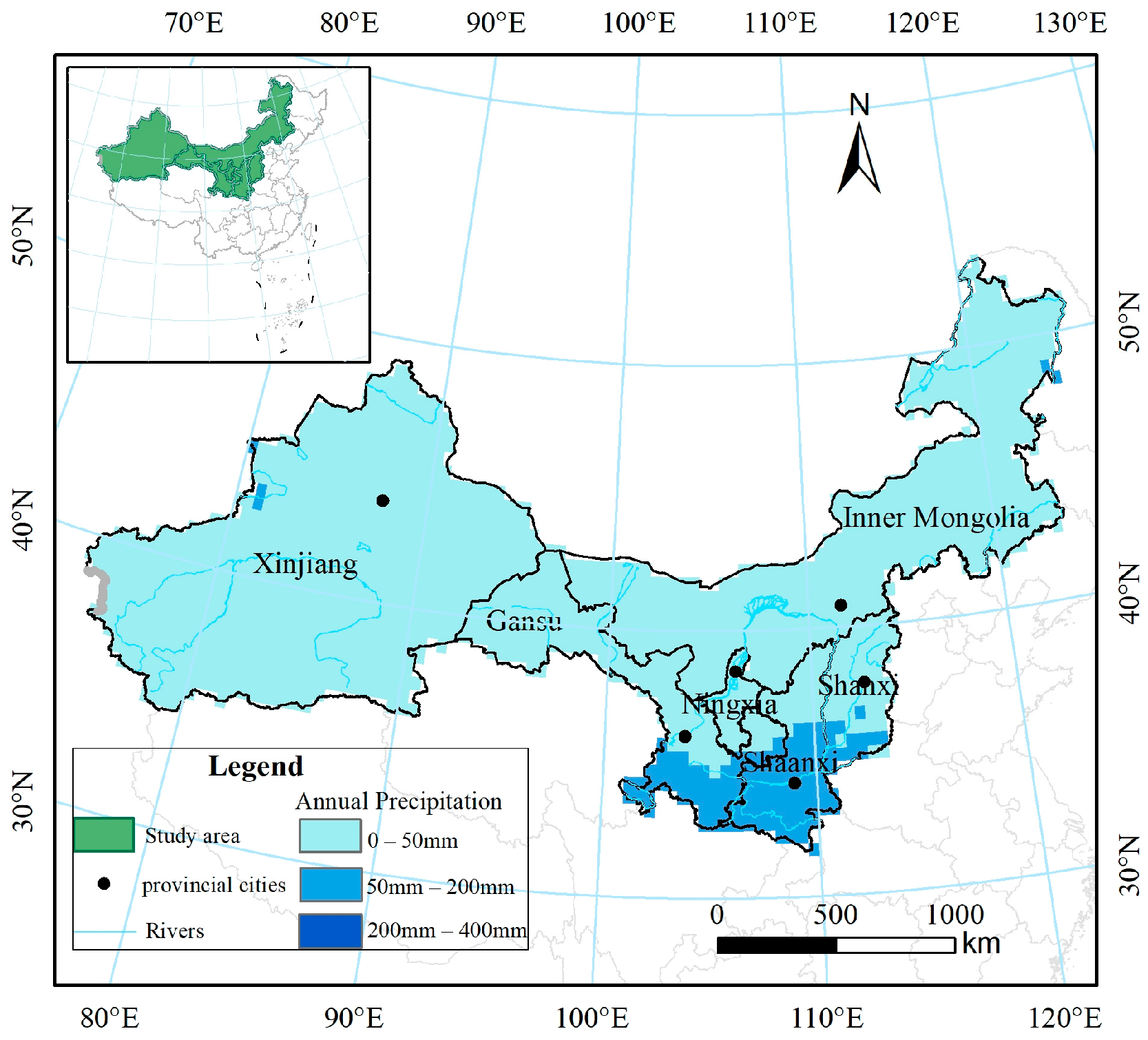
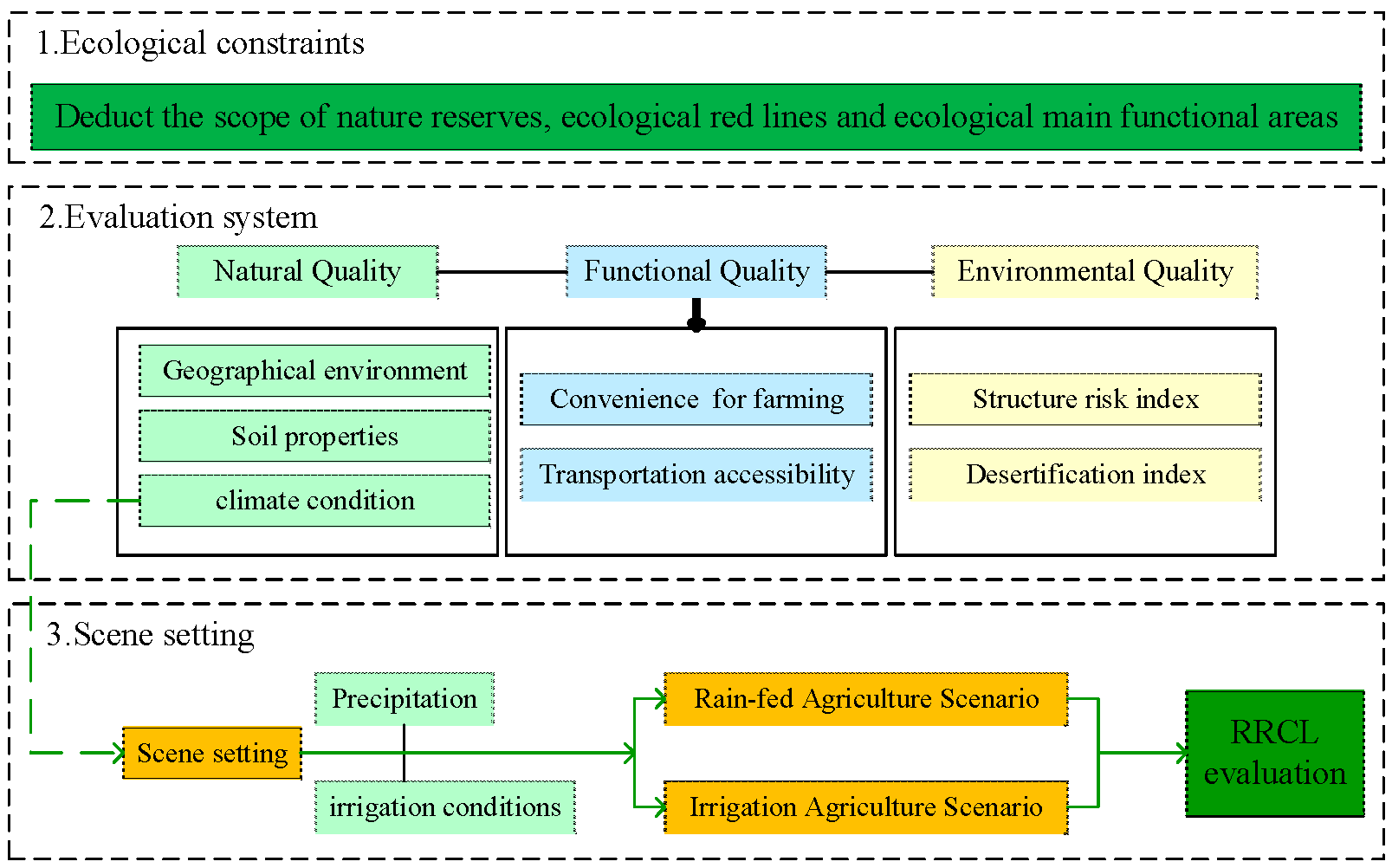
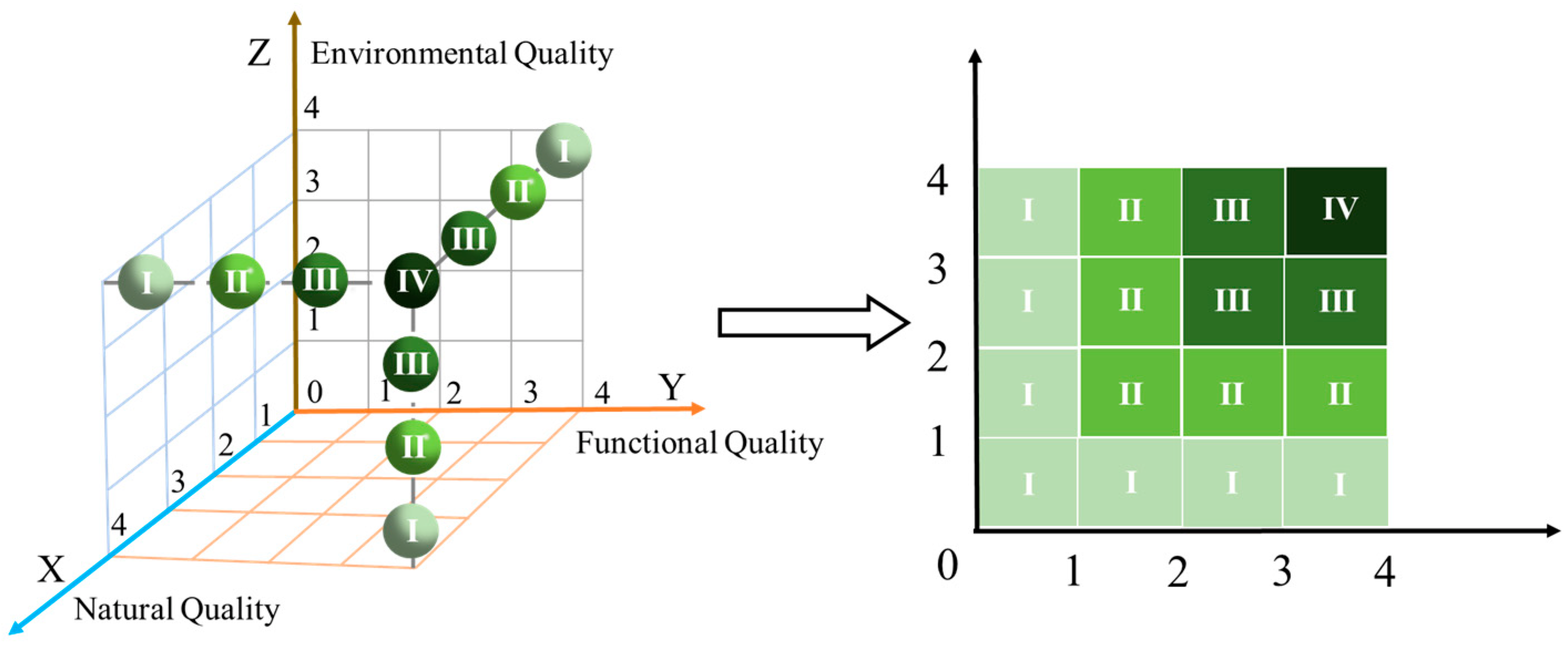
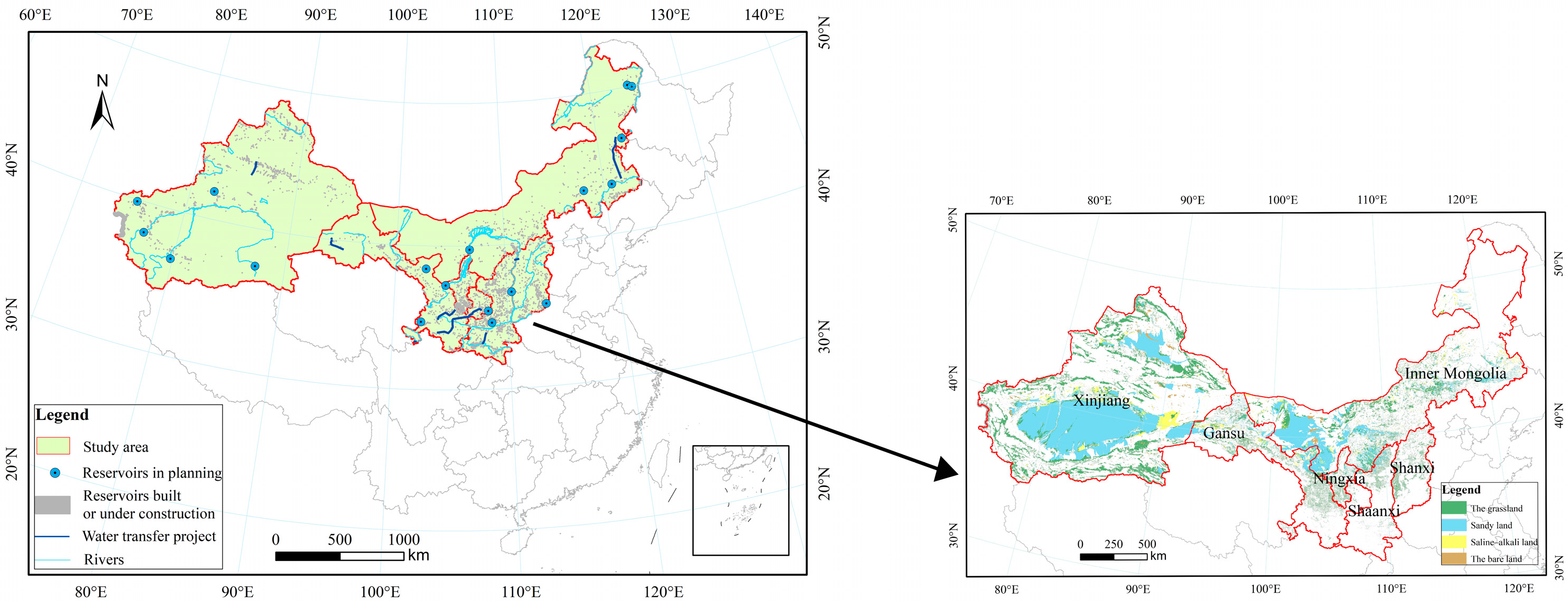

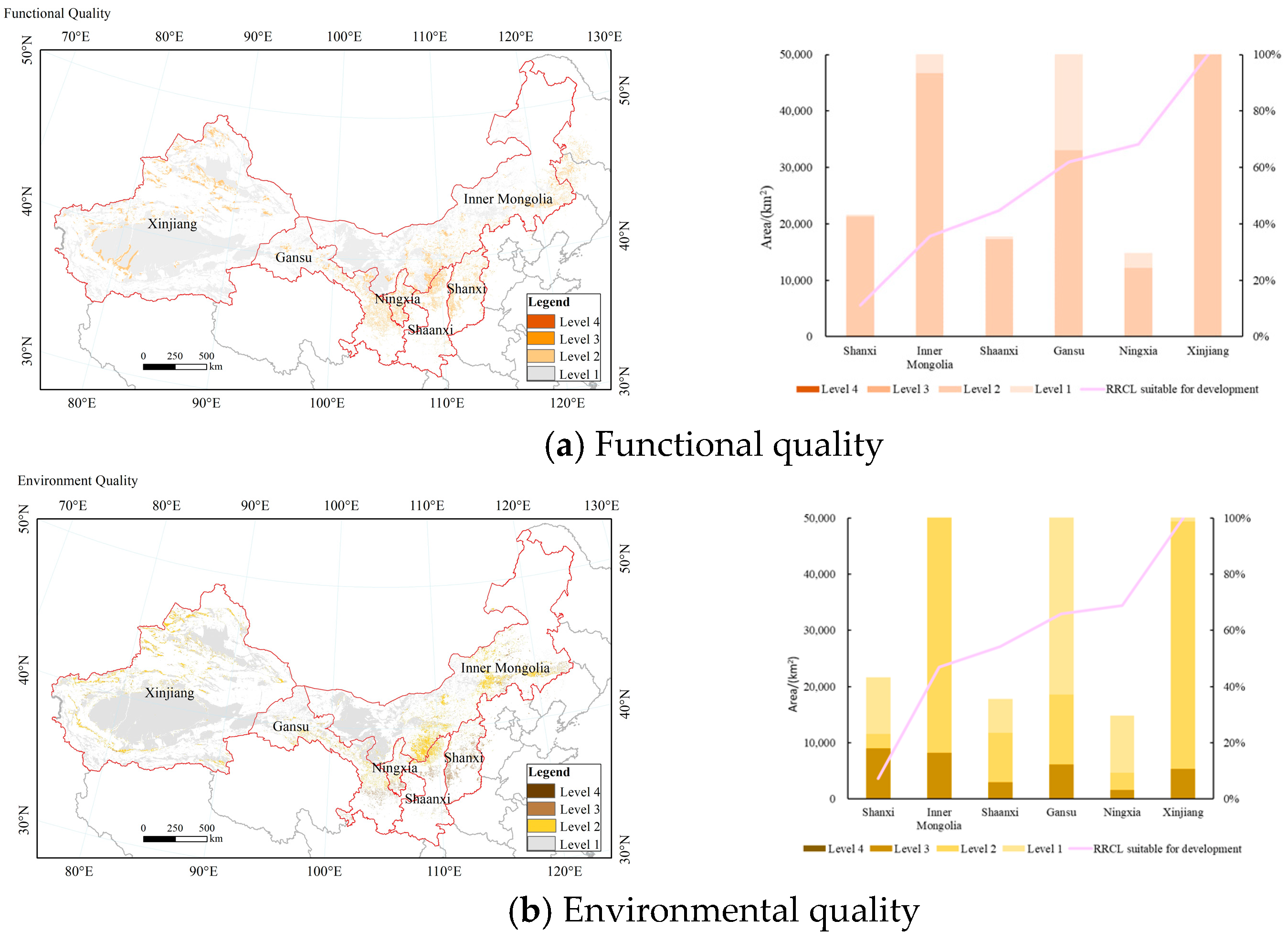
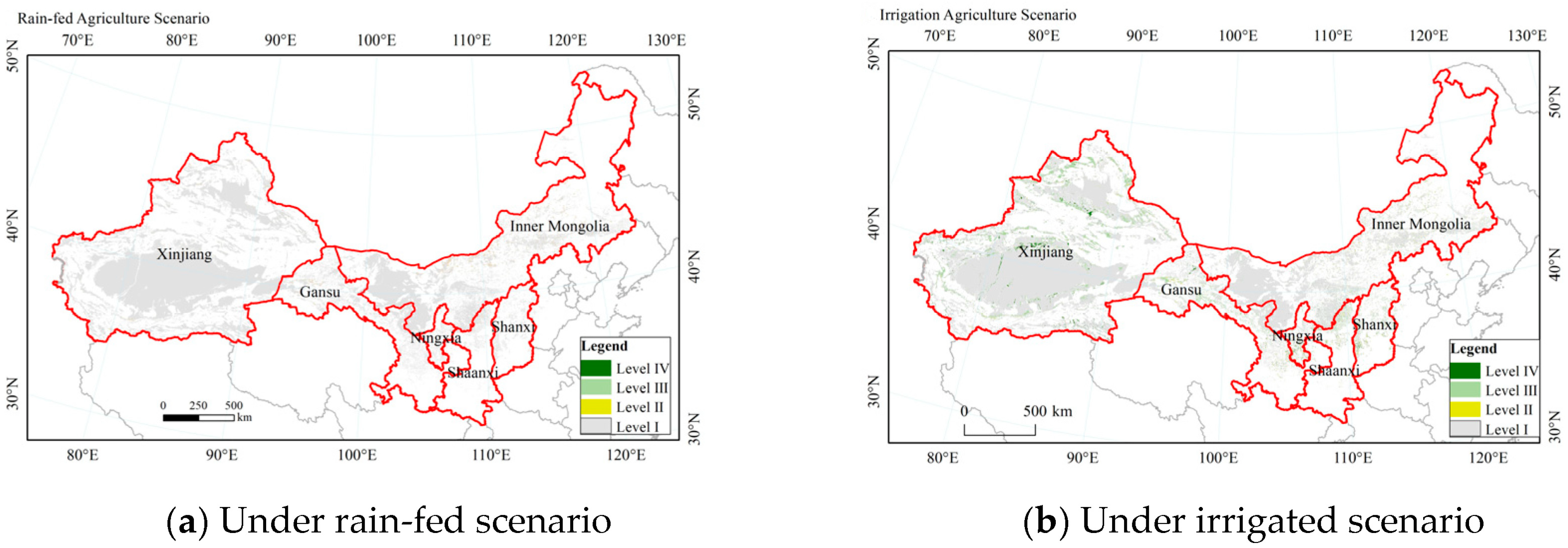
| Dimensions | Condition Layers | Specific Meanings and Calculation Methods |
|---|---|---|
| Nature | geographical environment | The surface relief, slope, altitude, and slope direction indexes were weighted separately to measure |
| soil properties | Soil thickness, soil texture, soil sand content, and soil pH were weighted separately to measure the composite | |
| climate condition | The distinction between rain-fed and irrigated agriculture scenarios was defined by >10 °C cumulative temperature, sunshine hours, and precipitation conditions, or irrigation conditions were assigned separate weights for the combined measure | |
| Function | farming convenience | Straight line distance between the plot and the road |
| traffic accessibility | Linear distance between the land and the village | |
| Environment | Structural risk index | is the structural ecological risk index; is the area of the th type of land use, in km2; A is the total area, in km2; is the weight of the ecological risk index of the ith type of land use |
| desertification index | is the vegetation cover, is the desertification index |
| Comprehensive Levels | Rubik’s Cube Property Combination |
|---|---|
| Level IV | (4, 4, 4) (4, 4, 3) (4, 3, 4) (4, 3, 3) (3, 4, 4) (3, 4, 3) (3, 3, 4) (3, 3, 3) |
| Level III | (4, 4, 2) (4, 4, 1) (4, 3, 2) (4, 3, 1) (4, 2, 4) (4, 1, 4) (4, 2, 3) (3, 4, 2) (3, 4, 1) (3, 3, 2) (3, 2, 4) (3, 2, 3) (3, 2, 3) (2, 4, 4) (2, 4, 3) (2, 3, 4) (2, 3, 3) (1, 4, 3) (1, 4, 4) |
| Level II | (4, 2, 2) (4, 2, 1) (4, 1, 1) (4, 1, 2) (4, 1, 3) (3, 1, 4) (2, 4, 2) (1, 3, 1) (2, 1, 4) (2, 4, 1) (1, 4, 1) (1, 1, 4) (1, 1, 3) (1, 3, 4) (1, 4, 2) (1, 2, 4) (2, 3, 2) (2, 2, 4) (2, 2, 3) |
| Level I | (2, 2, 1) (2, 1, 2) (2, 1, 1) (1, 2, 2) (2, 2, 2) (1, 2, 1) (1, 1, 2) (1, 1, 1) |
| Scenarios | Level 4 | Level 3 | Level 2 | Level 1 | ||||
|---|---|---|---|---|---|---|---|---|
| Properties | Area | Percentage | Area | Percentage | Area | Percentage | Area | Percentage |
| Rain-fed | 2687 | 0% | 7916 | 1% | 27,342 | 3% | 999,785 | 96% |
| Irrigation | 46,110 | 4% | 63,384 | 6% | 18,821 | 2% | 909,415 | 88% |
| Scenarios | Rain-Fed Agriculture | Irrigated Agriculture | ||||||||||||||
|---|---|---|---|---|---|---|---|---|---|---|---|---|---|---|---|---|
| Levels | Level IV | Level III | Level II | Level I | Level IV | Level III | Level II | Level I | ||||||||
| Provinces | Area | % | Area | % | Area | % | Area | % | Area | % | Area | % | Area | % | Area | % |
| Shanxi | 318 | 5% | 225 | 2% | 561 | 2% | 20,540 | 2% | 4242 | 7% | 2097 | 2% | 1701 | 3% | 13,604 | 2% |
| Inner Mongolia | 4121 | 61% | 6140 | 56% | 9677 | 34% | 241,759 | 24% | 18,513 | 32% | 31,381 | 35% | 14,864 | 23% | 196,939 | 24% |
| Shaanxi | 274 | 4% | 294 | 3% | 623 | 2% | 16,572 | 2% | 2231 | 4% | 2211 | 2% | 1478 | 2% | 11,843 | 1% |
| Gansu | 556 | 8% | 408 | 4% | 2390 | 8% | 86,968 | 9% | 5877 | 10% | 8989 | 10% | 6816 | 11% | 68,641 | 8% |
| Ningxia | 216 | 3% | 161 | 1% | 540 | 2% | 13,913 | 1% | 2825 | 5% | 1430 | 2% | 1361 | 2% | 9215 | 1% |
| Xinjiang | 1310 | 19% | 3751 | 34% | 14,951 | 52% | 611,461 | 62% | 24,257 | 42% | 43,717 | 49% | 37,986 | 59% | 525,511 | 64% |
| Total | 6794 | 10,980 | 28,742 | 991,214 | 57,945 | 89,825 | 64,206 | 825,753 | ||||||||
| Percentage | 1% | 1% | 3% | 96% | 6% | 9% | 6% | 79% | ||||||||
Disclaimer/Publisher’s Note: The statements, opinions and data contained in all publications are solely those of the individual author(s) and contributor(s) and not of MDPI and/or the editor(s). MDPI and/or the editor(s) disclaim responsibility for any injury to people or property resulting from any ideas, methods, instructions or products referred to in the content. |
© 2023 by the authors. Licensee MDPI, Basel, Switzerland. This article is an open access article distributed under the terms and conditions of the Creative Commons Attribution (CC BY) license (https://creativecommons.org/licenses/by/4.0/).
Share and Cite
Yao, Y.; He, G.; Li, W.; Zhao, Y.; Li, H.; He, F. Assessing the Influence of Water Conservancy Projects on China’s Reserve Resources for Cultivated Land. Land 2023, 12, 1811. https://doi.org/10.3390/land12091811
Yao Y, He G, Li W, Zhao Y, Li H, He F. Assessing the Influence of Water Conservancy Projects on China’s Reserve Resources for Cultivated Land. Land. 2023; 12(9):1811. https://doi.org/10.3390/land12091811
Chicago/Turabian StyleYao, Yuan, Guohua He, Wei Li, Yong Zhao, Haihong Li, and Fan He. 2023. "Assessing the Influence of Water Conservancy Projects on China’s Reserve Resources for Cultivated Land" Land 12, no. 9: 1811. https://doi.org/10.3390/land12091811
APA StyleYao, Y., He, G., Li, W., Zhao, Y., Li, H., & He, F. (2023). Assessing the Influence of Water Conservancy Projects on China’s Reserve Resources for Cultivated Land. Land, 12(9), 1811. https://doi.org/10.3390/land12091811







